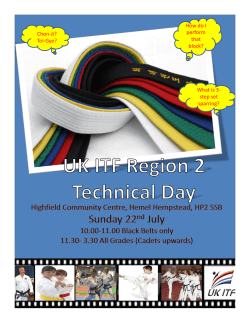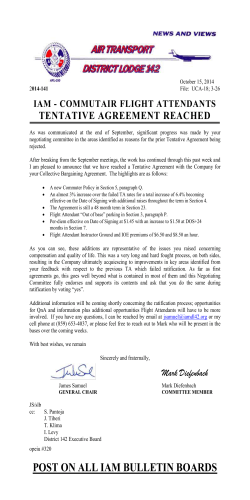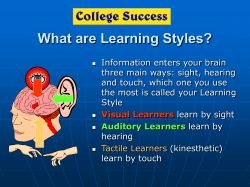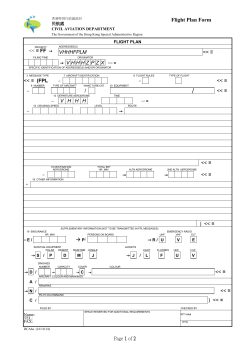
Aviation and Flight Educators: Perspectives from Master Instructors and Flight
Aviation and Flight Educators: Perspectives from Master Instructors and Flight Instructors of the Year Michael G. Gaffney - Panel Moderator Deputy Director of Supply Chain and Logistics AAR Airlift Melbourne, FL http://www.Flightlogics.com Welcome • Michael G. Gaffney – Panel Moderator – – – – – – – – – – – – – 2007 National CFI of the Year 2007 NATA Flight Training Excellence recipient 4 Time Master CFI (MCFI) 2 Time Master Ground Instructor (MGI) FAAST Lead Representative FAA Production Studio Sound Engineer AFS-520 TAA Course Designer/SME Gold Seal CFI Cirrus CSIP Cessna CFAI Quest Kodiak Factory Instructor Diamond FITS Accepted Instructor ASA G1000 and ASA Entegra Course Author Our Panelists Arlynn McMahon – 2009 National CFI of the Year Jeffrey Edwards – 2003 National CFI of the Year Jeffrey Robert “MossY” Moss – 2010 National CFI of the Year Panel Agenda 5 mins – Intro/Objectives Michael Gaffney 10 mins –Teaching Michael Gaffney Higher Order Pilot Skills 10 mins – Preparing Real World Flight Training Arlynn McMahon 10 mins – Initial/Recurrent CFI Certification Jeff Edwards 10 mins – Technology Jeffrey Robert Moss “MossY” & Syllabus Syndrome 10 mins – Panel Discussion 5 mins – Q&A and Summary Mike Gaffney Objectives Major Themes of This Panel • Enhance professionalism of our trade • Set example for instructional educators • Raise the bar on instructional quality standards • Focus on renewed emphasis of scenario based skills • Enhance the requirements for flight instructor certification to achieve excellence in our field • Decrease student dropout rate • Define standards for TAA instructional “certification” • Decrease accident rate by increasing effectiveness of instructional process Points for Further Discussion in Thursday Breakout Sessions How to reverse complacency of many flight Instructors? Does self-examining authority of “pilot mill” schools create problems? Deep systems understanding required to teach in a world of complex equipment Flight Instructors must be taught how to perform their job, not taught to pass a test How to measure and ensure quality if we have 90,000+ flight instructors? Scenario driven instruction must be the focus of all training and eventually, all testing PTS needs to be a testing tool, not a training tool A syllabus must be used for training and the student instructor in training needs to be key to its proliferation in the industry Student Instructors in training should be taught to do paperwork and logbook entries from day 1 Some aspects of mentorship and experience accomplishment must be integrated into our training system so that kids are not teaching kids (inexperience proliferation) Specific type equipment checkouts and certifications should be achieved in the industry to ensure that experience is teaching not experimentation. Current method of initial CFI training and recertification has been designed for convenience and affordability, not for safety Contacts Michael Gaffney – (321)-298-8910 [email protected] Arlynn McMahon – (859) 983-2709 [email protected] Jeff Edwards – (314) 308-6719 [email protected] Jeff Moss – (310) 966-7655 [email protected] Presentations can be downloaded at http://www.Flightlogics.com Aviation and Flight Educators: Perspectives from Master Instructors and Flight Instructors of the Year “Teaching Higher Order Pilot Skills” Michael G. Gaffney - Panel Moderator Deputy Director of Supply Chain and Logistics AAR Airlift Melbourne, FL http://www.Flightlogics.com Major Themes • We must demand professionalism of our students • We must demand professionalism of ourselves! • Mastery of technology is only one part of the process of learning to fly • What happened to the days of deep system understanding? • Button pushing is not a valid level-set for learning TAA • The CFI certification process has gotten complacent • Professionals only teaching in advanced cockpits: How do we tell the difference? Evolution of General Aviation is well Underway Many of us were taught to fly in these… OR 1969 Citabria 1976 Cessna C172 Now we are flying in this… Or this… Cirrus with Avidyne Release 9 Or This… Cirrus with Garmin Perspective Tale of the GA Training Cockpit Cockpit Safety starts with the fundamentals of how we train Speed Relativity – Base 60 cockpit math Aircraft Transition Path from Training to Mission Platform Cessna 122 knots Can you keep up with the speed and technology of your mission platform? Diamond 138 Knots Fly the aircraft first always, regardless of the mission Quest Kodiak 155 Knots Cirrus 170 Knots Mooney 170 Knots Cessna Corvalis 400 225 Knots Diamond DJet 325 knots Instructional emphasis Limited number of hours we have with a student: Where do we spend our time? OR OR Pilot and instructor skills must evolve • Master Automation Operation • Disciplined Schooling • Understand Digital Appliances • New Techniques • Constant evaluation of options available • All while never losing sight of the basics! Keys to Keeping up with Technology • Know your equipment- blindfolded • Diligent training using realistic scenarios • Develop Aeronautical Decision Making (ADM) skills • Approach every operation with Risk Management in mind • Single Pilot Resources Management (SRM) • Maintain an inclusive Scanflow • Use all available tools to maintain situational awareness The Art of Managing a Busy Cockpit “What will Happen?” Planning and Contingent Planning “What is Happening?” Situational Awareness “What do I do about it?” Aeronautical Decision Making “Go back and modify the plan” Scanflow cockpit management Outside the Aircraft (Traffic and Terrain Avoidance Chores (Checklist, engine monitor, Chart management, passenger briefings, baby sit autopilot) Primary Flight Display (PFD) (Flight Parameter Adherence) Multi Function Display (MFD) (Electronic Situational Awareness NEXRAD, Stormscope, Traffic, Terrain, cabin entertainment) Conclusion • Evolution of technology will continue at its blistering pace • The pilot and the instructor must maintain proficiency over the all three aspects of Training; Flight Skills, Technology Management, and Systems Understanding • Safe use of cockpit technology remains an issue of distraction and complacency management • Always fly the aircraft first but know your technology and how it can help you Aviation and Flight Educators: Perspectives from Master Instructors and Flight Instructors of the Year Arlynn McMahon - Panel Member Preparing CFIs for the Real World • Arlynn McMahon • • • • • • • 2009 National CFI of the Year 10,000 hours dual given (that’s not total time – that’s dual given) Recipient, 2010 NATA Excellence in Pilot Training Author, Train Like You Fly, A Flight Instructor’s Guide to Scenario Based Training Published in numerous national magazines and in peer reviewed journals Gold Seal and 4 time Master Instructor Lead FAAST Representative McDonald’s Big Mac 2 all-beef patties, special sauce, lettuce, cheese, pickles, onions on a sesame seed bun What is a Good Instructor Customer Retention Accident Rate Semper Fi Boy Scout -Eagle • Requirement 1 -- Be active in your troop for at six months after you have achieved the rank of Life Scout. • Requirement 2 -- Demonstrate that you live by the principles of the Scout Oath in your daily life. • Requirement 3 -- Earn a total of 21 merit badges. • Requirement 4 -- While a Life Scout, serve actively for a period of six months in a position of responsibility. • Requirement 5 -- Plan, develop, and give leadership to others in a service project. • Requirement 6 -- Statement of ambitions and life purpose; hold Scoutmasters conference. Other Qualities Needed • • • • • Work Ethic Business Sense Respect Politeness Stand Up Straight, Smile and a Firm Handshake • A student pilot for life A Challenge What is your definition of a good instructor? One that you’d • Pay $100 per hour for • Work with • Hire to work in a fine flight school Aviation and Flight Educators: Perspectives from Master Instructors and Flight Instructors of the Year Jeff Edwards - Panel Member Welcome Jeffrey Edwards • 2003 National Flight Instructor of the Year • 6 time MCFI • President/ founder Lancair Owners and Builders Organization (LOBO) • Member GA JSC SAT team • Navy A-6 Bombardier/ Navigator, Navy Aircraft Accident Investigator/ IIC • McDonnell Douglas Boeing aircraft accident investigator • President AvSafe, LLC Aircraft Accident Reconstruction firm • Conducted over 500 aircraft accident investigations Flying Never Has and Never Will be Cheap and Easy! Initial & Recurrent CFI Initial • 40 hours total time to Private • 250 hours total time to Commercial • No additional flight training req’d for CFI • Very High Risk activity taught by mostly inexperienced individuals Recurrent • FIRC 16 classroom hours • Online FIRC—do it in your bathrobe! • 8710 • NO Flying Required! 3rd most dangerous occupation in America. Can we make it any easier and cheaper? Should we? Inexperience Hurts Experience Gained by Teaching • Jake By appointment Comm, CFIBS-Aviation Mgmnt SIUCarbondale • Flight Experience: 261 hrs, 15 Dual Given, 50 Inst; 23 ME Specialty: Single Engine • Kristy Available Fri-Sun Comm, CFI, CFIIBS-Aeronautics UM-CMSU • Flight Experience: 350 hrs, 85 Dual Given, 80 Inst; 50 ME Specialty: Single & Multiengine; Instrument; Advanced Ground Inst Inexperience Hurts • 37% of all accident pilots had fewer than 500 total hours* • 189 accidents during instructional flights in 2007 • 50% of all accidents occur to Private Pilots who operate less than 33% of the total hours *from AOPA ASF Nall report 2003 Where Does This End Up? In flying I have learned that carelessness and overconfidence are usually far more dangerous than deliberately accepted risks. — Wilbur Wright in a letter to his father, September 1900. • • I learned that danger is relative, and the inexperience can be a magnifying glass. — Charles A. Lindbergh You get what you pay for Loss of Control on Takeoff 18 Aug 1997 • Night dual flight at uncontrolled field • Witnesses observe aircraft land and taxi back on runway 17 • Aircraft departs, remains in ground effect, accelerates to end of runway and enters near vertical climb to approx. 200’AGL • Aircraft rolls right and descends vertically impacting terrain THE AFTERMATH OF A BAD DAY IBWTMLGOAKO • Instructor had demonstrated his “signature takeoff” to students a number of times including a “SH” t/o in front of two sheriff deputies • Instructor was student at Spartan School of Aeronautics. While there he failed private, instrument & commercial initial checkrides and flight instructor ride and retest IBWTMLGOAKO • Instructor was new hire in Nov. 1996 and had 944 total hours with 17 hours in model and 1.5 hours in model at nx. • Students aware of flight instructor’s practice • Management not • Flight instructor’s failure to maintain aircraft control during takeoff and climb. • Flight instructor’s lack of experience in make and model Pilot Certificates • • • • • • • • • • • • • • • • • • • • • Year Student 2009 72,280 94,863 2008 80,989 93,202 2007 84,339 2006 84,866 2005 87,213 2004 87,910 2003 87,296 2002 85,991 2001 94,420* 2000 99,110* 1999 99,184* 1998 97,736 1997 96,101 1996 94,947 1995 101,279 1994 96,254 1993 103,583 1992 114,597 1991 120,203 1990 128,663 Rec 234 Private 211,619 Commercial ATP 125,738 252 222,596 124,746 239 239 278 291 310 318 318 340 343 305 284 265 232 241 206 187 161 87 211,096 115,127 219,233 117,610 228,619 120,614 235,994 122,592 241,045 123,990 260,845 137,504 261,927 137,636 251,561 121,858 258,749 124,261 247,226 122,053 247,604 125,300 254,002 129,187 261,399 133,980 284,236 138,728 283,700 143,014 288,078 146,385 293,306 148,365 299,111 149,666 Other Total CFI 144,600 146,838 594,285 613,746 143,953 590,349 92,175 141,935 597,109 91,343 141,992 609,737 90,555 142,160 618,633 89,596 143,504 625,011 87,816 147,104 29,596 661,358 86,089 146,989 16,200 657,490 82,875 141,598 17,162 631,629 80,931 137,642 17,118 637,297 79,694 134,612 16,366 618,298 79,171 130,858 16,195 616,342 78,102 127,486 16,374 622,261 78,551 123,877 18,417 639,184 77,613 117,434 17,195 654,088 76,171 117,071 17,495 665,069 75,021 115,855 17,857 682,959 72,148 112,167 17,893 692,095 69,209 107,732 17,400 702,659 63,775
© Copyright 2025












